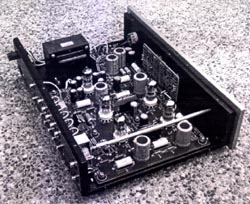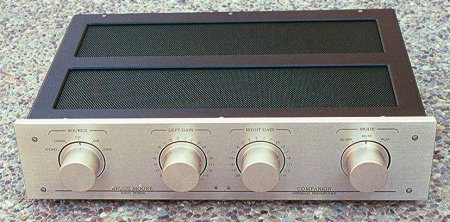The Bruce Moore Audio Design Companion III Vacuum Tube Preamplifier
| The Bruce Moore Audio Design Companion III Vacuum Tube Preamplifier |
|
Henry Wilkenson |
|
6 June 2001 |
Gain: 23 dB
Frequency Response: 1 Hz to 500 kHz +0, -1dB
Maximum Output: 25V RMS
THD: < .03% @ 2V RMS out
Input Impedance: 75K ohm
Output Impedance: 500 ohms
Noise: -98dB below 2V RMS output
Absolute Phase: Non-Inverting
Tube Complement: 3 ea. 6DJ8/6922, 2ea 12AU7
Power Consumption: 30 watts (detachable line cord)
Dimensions: height = 3.6″ (79 mm), width = 16″ (381 mm), depth = 12″ (241 mm)
Shipping Weight: 20 lbs.
Notes: Has 5 Line Inputs, Main Out and Tape out
Price: $3000
Description
The Bruce Moore Companion III preamplifier is a well designed high end line stage in the middle of the Bruce Moore line between the Companion II-b at $1650 (?) and the Dual Mono Preamplifier at $6550.00. There is also the Dual 70, 70 watt tube power amp at $4300.
You’ll need a firm grip in trying to lift the Companion III. Although its shipping weight is listed at twenty pounds, it feels heavier. This is a solid, well put together piece of gear. The faceplate consists of a quarter-inch slab of brushed aluminum adorned by four large rotary knobs. The first from the left is the source selector. It controls the choices for phono, tuner, CD1, CD2 and tape. (Remember, this is a line stage. There isn’t any phono stage. You’ll need to connect your own.) The next two knobs are for the left and right channel volume controls. They’re detented, making it much easier to set the balance between left and right channels. The last knob is the mode selector. It controls the mute and a/c on/off. You may leave the pre-amp warmed up in the mute position between listening sessions. One caveat: you must engage the mute before switching between sources. Otherwise, you will cause a large thump that will do your system no good. There are two small blue lights at the bottom center of the faceplate. The first indicates power-up. The second lights up when you take the pre-amp out of mute. All controls are straightforward and easy to use. Their solid feel is commensurate with a high quality pre-amp.
A peek inside reveals a well-laid out circuit board loaded with high quality parts and the five tubes listed in the headnote.
The rear panel sports a total of fourteen RCA connectors straightforward in their layout. They do not appear to be gold plated but are of high quality nonetheless. There is also a conveniently placed fuse holder and an IEC socket for the detachable power cord. (Something else to tweak.)
Aside from the sound of tube gear, another advantage the pre-amp offers is the ability to tailor the sound by changing tubes. How many of you have gone to the expense of chasing down NOS (new old stock) because you absolutely must have Mullards or Telefunkens with their legendary characteristics? In this case, there are only five tubes to contend with, but that can still be expensive if your tastes run toward matched sets. Fortunately, pre-amp tubes tend to last for quite a while.
The Sound
 Quality of parts and build is all well and good, but they don’t mean a thing unless they swing. So, how does this pre-amp sound? Very good, I’m glad to say. The overall character of the Companion III tends to the warm side. This is not surprising, given its tube design. Please don’t misunderstand, this is not yesteryear’s “classic” tube signature. It’s not syrupy or overly euphonic. Rather, it renders a rich harmonic picture that allows the differences between two musicians playing the same instruments to be clearly perceived. Overall, I find that the Companion III really underscores the differences between recordings. Good recordings sound very, very good while poor ones are hard to hear by comparison. I won’t give you a blow by blow account of every recording that I used to evaluate the Companion III – just the ones I found to be particularly noteworthy.
Quality of parts and build is all well and good, but they don’t mean a thing unless they swing. So, how does this pre-amp sound? Very good, I’m glad to say. The overall character of the Companion III tends to the warm side. This is not surprising, given its tube design. Please don’t misunderstand, this is not yesteryear’s “classic” tube signature. It’s not syrupy or overly euphonic. Rather, it renders a rich harmonic picture that allows the differences between two musicians playing the same instruments to be clearly perceived. Overall, I find that the Companion III really underscores the differences between recordings. Good recordings sound very, very good while poor ones are hard to hear by comparison. I won’t give you a blow by blow account of every recording that I used to evaluate the Companion III – just the ones I found to be particularly noteworthy.
I’ve made no secret of my fondness for Mapleshade CDs. I appreciate the analogue quality they consistently exhibit. The Clifford Jordan Quartet’sLive at Ethell’s is one of the best examples of the Mapleshade sound. The listener is presented with a wide soundstage with an appropriate sense of depth. The instruments are well located within the stage, but nothing is etched or overdone imagewise. Rather than a razor sharp edge around any instrument, I heard a very natural if somewhat soft focus. The sonic cues that give a sense of room size come across very nicely. You know that this is a live recording, but at the same time there isn’t any hyper-detail. You won’t hear any pins dropping here.
Carmen Lundy’s Self Portrait is a particularly well done JVC XRCD recording. I noticed a remarkable degree of midrange transparency but again, neither cold or sterile. These qualities were true of all of the digitally recorded XRCDs.
For this review, I paired the Companion III with the bel canto EVo power amp. Since the noise floor of the bel canto is extremely low, it’s not surprising that I heard a trace of tube noise when I placed my ear within a few inches of the speaker. However, I never heard it from my listening position. It never interfered with the music.
I find that midrange transparency is something of a common denominator of high-end gear. I particularly listen to piano recordings to see how well that tonally complex instrument comes across. The piano’s harmonic structure and decay rates are fairly difficult for many systems to reproduce with any degree of realism. The Companion III did not disappoint in any way here. It’s clarity allows you to “hear into” the soundstage minus the veils common in varying degree to lesser gear.
Is the Companion III perfect? Of course not! What is? Compared to another line stage I’m familiar with, it was a little less refined in two ways. While listening to a performance of Charpentier’s Concerto Vocale on the harmonia mundi label, the Companion III did not quite have the resolution of the other line stage. It introduced a small degree hardness to vocal passages. I have to emphasize these are very small points. The other line stage costs $2K more. In all other respects, the Companion III is competitive with the higher priced spread. For the additional $2K, you can resolve a picked nit and a half.
The Companion III came with four Vibrapod footers. I placed the pre-amp on three Poly Chrystal cones on a Rosinante shelf, two accessories accounting for a large sonic improvement at the frequency extremes and in soundstage focus. The bass was much more extended and articulate, the top more open and a touch sweeter. On good recordings, the soundstage was wide and deep, but instrumental placement and proportions remained realistic.
This is a line stage that I could easily live with. It is so good, in fact, that it piques my curiosity about the Bruce Moore Dual Mono line stage. In any event, if you are in the market for a line stage, you really should give this one a listen, particularly if you are prepared to spend more that the $2,600 asking price.
The Music
|
Clifford Jordan Quartet, Live at Ethell’s |
Mapleshade |
|
Carmen Lundy, Self Portrait |
JVCxrcd |
|
Marc Antoine Charpentier, Concerto Vocale |
harmonia mundi |
|
Charlie Byrd, For Louis |
Concord |
|
Shirley Horn, I Thought About You |
Verve |
|
Gene Harris, Live at Otter Crest |
Concord |
![]()
Don’t forget to bookmark us! (CTRL-SHFT-D)
Stereo Times Masthead
Publisher/Founder
Clement Perry
Editor
Dave Thomas
Senior Editors
Frank Alles, Mike Girardi, Russell Lichter, Terry London, Moreno Mitchell, Paul Szabady, Bill Wells, Mike Wright, and Stephen Yan,
Current Contributors
David Abramson, Tim Barrall, Dave Allison, Ron Cook, Lewis Dardick, John Hoffman, Dan Secula, Don Shaulis, Greg Simmons, Eric Teh, Greg Voth, Richard Willie, Ed Van Winkle, Rob Dockery, Richard Doron, and Daveed Turek
Site Management Clement Perry
Ad Designer: Martin Perry


 Specifications
Specifications


Be the first to comment on: The Bruce Moore Audio Design Companion III Vacuum Tube Preamplifier